|
Gardening Diary of
|
Unfortunately the diary is on temporary suspension due to the amount of work I have on. I may not be able to begin regular entries until the end of the year. But I will be updating and adding pages to the Home of the Organic Gardener Website.
4th April 2006 - Gardening Diary Entry
GARDENING PLANS FOR 2006
Well the seed potatoes have arrived and the new fruit cordons - 3 apple varieties, plus a Jostberry, and Tayberry.
I've bought a new push mower.
I'm going to try a different method of growing runner beans arching over a taller long tent of canes. One more for the gardening diary a little later.
21st March 2006 Gardening Diary Entry
THIS SPRING BEGINS WITH WATER SHORTAGE ?
I've since published a page with detailed advice on watering the garden.
It's true! Important resevoirs supplying the U.K. are virtually empty. Low pressure areas with rain bearing weather fronts are off course way up north... or perhaps it's the jet stream. Drier continental highs cover central and southern U.K.
Hose-pipe bans are planned already. Gardeners and all are discouraged from wasting water - washing patios and cars etc... needless to say... don't leave taps running and, do remember to turn the tap right off when finished.
Oh dear, gardeners are in trouble. We'll be awash with argument on what water usage is banned and what is allowed - allotments OK, gardens hoses at home NO, Car washing services OK, car wash in your own drive NO ???
AS ALWAYS I'LL TRY TO SUGGEST AN ORGANIC SOLUTION FOR GARDENING
- Cultivate deeply. Deep roots gives your plants access to more soil water. Click here for an easy way to build raised beds.
- Let the grass grow longer to encourage deep rooting.
- Ensure plants grown from seed for transplanting develop deep root runs - see Rootrainers.
- Avoid containers, but if you use them ensure the surface is covered in plastic or grit to reduce evaporation. see container gardening
- Use plastic sheet or loose mulch to reduce water loss to air. See my pages on mulching
- Incorporate plenty of organic matter into soil - leaf mould, garden compost, manure, etc...
- Water your garden plants early morning or evening. One good watering is better than many light waterings. Don't spray water into the air.
- You should have been saving whatever water you can collect. There are some good space-saving water butts available that can tie into down spouts from guttering. Go to Water Butts at Ferndale Lodge...
- Lay a narrow perforated pipe under the soil to the outer root zone weaving between plants.
The gardening diary is going to be interesting - if I get time enough to write it.
Check for the latest updated web pages on Home of The Organic Gardener
Transferred From Previous Gardening Diary Blog Site
- Blogs Before 14th March 2006 -
Friday 13th January 2006 Gardening Diary Entry
The Box Next Door
By now you may have seen Blue Tits already looking around for possible nesting sites - this post is a bit late.
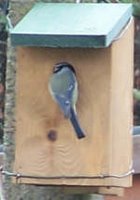 I'm always curious to see them checking the bird boxes. They land outside the hole, and with all the mannerisms of a nosy neighbour, look inside while checking around outside as if to see that no one is watching them.
I'm always curious to see them checking the bird boxes. They land outside the hole, and with all the mannerisms of a nosy neighbour, look inside while checking around outside as if to see that no one is watching them.
I may be wrong but I believe that they are scent marking the hole, perhaps using oil glands around their beak, so as to keep their rivals away.
Well if you haven't put up a nesting box by now, it may soon be too late.
Last week I noticed a finch come down to the water when it was frozen. Instead of water it splashed the frost over its wings. Do leave out some food and unfrozen water for the birds.
Friday 30th December 2005 Gardening Diary Entry
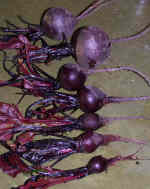 |
| boro f1 hybrid |
I left my beetroot in the ground as I only had a few. But it was very satisfying to go down the garden on Chrismas Eve and dig up a handful or two.
After washing and cleaning I took half to a friend and the rest I peeled, before cooking in the microwave for eating with a cottage pie, sprouts and peas. I think it is important to remove all the peel as it can add a bitter taste. Also, I found they need exta cooking time to other vegetables.
I had noticed a month ago that the beetroot leaves stained the white frost red from the juice leaking out. Although they discolour water these roots didn't bleed even when cut. In the picture the dark patches are on moist areas, the light areas have dried. They do need to be kept moist.
I think it is better to lift beetroot in late autumn and store in moist peat or vermiculite contained in a ventilated box. Just a couple of these roots had a small hole, nothing to worry about. But storage reduces the risk of pest damage as well.
Saturday 17th December 2005 Gardening Diary Entry
Christmas Post an Organic View
 |
| Thank you Eric & Beryl for the lovely flowers |
 |
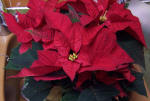 |
| Thank you John; this year the Poinsettia looks even move vivid & the flowers inside the red bracts larger & more promising. |
Yet sending Christmas cards is also one of those things that happens to gardeners. Christmas preparations are like a flower coming into bloom and then moving on to make seeds. Happily I've completed and posted my Christmas cards for 2005. In case you don't receive one from me, may I wish you all a happy Christmas.
But I also detect that some of you organic gardeners may not send Christmas cards at all. Why ? Because it's too commercial and we're not going to be taken in by all that gloss. Moreover, when we do send cards we look for cards printed on recycled paper. I wonder how many acres of forests are culled for Christmas cards?
While I understand the 'Green' message very well, I'm a little concerned that any dictates insisting people send recycled Christmas cards or emails instead, could be counter productive in gaining public support for the proper care of our environment. I believe persuasion and demonstration of the cause and cure of environmental problems is necessary. But then, trust people to take action out of conviction rather than compulsion. We know it makes sense.
Happy Christmas.
Sunday 11th December 2005 Gardening Diary Entry
The Scale of House Plants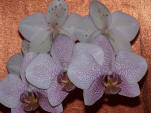
The Phalaenopsis pictured right was given to me about 2 and 1/2 years ago. It has been extraordinarily beautiful in flowering 2 times a year - in April-June and again October to Christmas. Each time the flowers are long lasting.
The picture shows a truss of 6 flowers - 3 facing camera and 3 facing away. But take a close look at the petals facing away (upper most in the picture). Those spots are not made for insects approaching the wrong way. No, they are not petal blotches, but scale insects.
Scale insects are small brown shield shaped creatures that suck sap. This plant has been afflicted by them since I got it. But until now I've only noticed them on the leaves. The treatment is to gently rub them off with finger and thumb. They come off quite easily. You could use a damp cloth. Some gardeners recommend methylated spirit or soap, but I don't think chemicals are necessary as they come off easily. Anyway, I won't be de-scaling the petals of these beautiful flowers until they wilt. I will keep a close organic gardener's eye on it to ensure the infestation doesn't spread to other plants and is kept well in check.
Brief Note on Phalaenopsis Cultivation
Phalaenopsis was supplied in a transparent plastic pot packed full of fleshy root like growths with a silvery skin and rooted in some kind of bark mixture. I only water it seldomly, every 2 weeks and, often far less in fact. Certainly don't over water, and except for a few drops at the bottom that should be absorbed quickly, don't leave immersed in water.
The roots green up down below (hence the transparent pot to let light in) and I think they may contain nitrogen fixing microorganisms. The plant has lost 1 or 2 leaves per year so far but it grows new ones. Before shedding, these old leaves are drained of all green and they turn yellow and dry as a husk. I think Phalaenopsis is able to re-absorb the vast majority of nutrient from the old leaves and re-cycle them to new leaves. So don't cut them off prematurely - this may be the reason why most Phalaenopsis only flower once a year. It seems that the plant doesn't need much in the way of food. Except for stuffing the dried up dead leaves into the outer container I've not fed it.
All told this is one of the most delightful house plants that I could recommend to the novice organic gardener.
A Splint To Repair Damage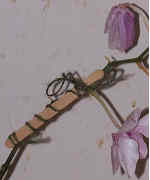 The flower stem grows horizontally if left alone. This is not the best position for displaying the flowers. Therefore, at an early stage while the flower stem is young and supple, tie it to an upright stick.
The flower stem grows horizontally if left alone. This is not the best position for displaying the flowers. Therefore, at an early stage while the flower stem is young and supple, tie it to an upright stick.
In the example pictured here the flower stem began leaning badly and I fixed a splint made from a wooden lolly pop stick to help straighten it again.
Thursday 1st December 2005 Gardening Diary Entry
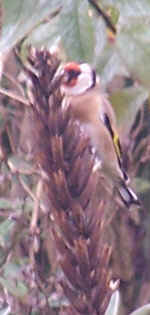
Over Weeding Cleans Out Birds For Winter
Pictured right, a recent siting of Goldfinch gleaning seed heads of Evening Primrose. The yellow flowers born on spikes are lightly scented and attractive to moths. Leaving them to seed risks getting a fresh crop of this biennial flower.
But if I remove them, I clean out all the seeds that are food for these beautiful finches and others. There are many plants that you can leave in for bird food. Berries - Hawthorn, Cotoneaster, Mountain Ash, and Rose-hips, plus seed capsules like Evening Primrose.
The Royal Society For The Protection Of Birds recommend that food be left out for garden birds all year around. That's not surprising as gardens usually degrade the bird's natural habitat and serverely reduce the naturally available bird food.
But in winter especially, gardeners should leave out bird food in squirrel resistant feeders. Specially designed nut mixes are readily available for purchase. Also ensure fresh liquid water is available.
Friday 25th November 2005 Gardening Diary Entry
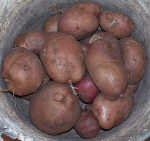
Potato Harvest
This week began as I finished harvesting my pototoes. I grew Desiree in large and strong plastic bags - a sample of the harvest is pictured here.
They taste OK boiled, are firm, and beautifully clean potatoes. The leaves and stems were also clean and green (but I don't eat them of course). Growing potatoes in bags and containers seems to drastically reduce the impact of soil pests (e.g. no slugs), and probably reduces disease too.
But I was a bit disappointed at the yields (maximum 41 tubers from 4 plants in a bag). I'll do better next time. The work involved in container growing should not be underestimated. However, it is ideal for a yard situation.
Friday 18th November 2005 Gardening Diary Entry
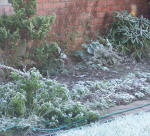
FROST - FROST - FROST
In the north west of England we often get milder weather due to the maritime influence. So here you may have just missed any frost - that is up until this week.
The last few mornings have been white until midday. A blocking high pressure area is keeping the skys clear and blue.
10th November 2005 Gardening Diary Entry
Fall Gardening - Tidying Up
I tidied away the Runner Beans, Sweet Peas and outdoor Tomatoes. I've already harvested sufficient over ripe pods for next year's seed. But, yesterday there was still about a handful of beans for the pot, and the leaves were green and unblemished. However, low light and temperatures have brought productivity to an end as evidenced by a few bean pods dying back or with wilted tips. So I cut the ties, removed the canes, and broke off the stems at ground level for composting. It's remarkable how swollen and fibrous the bean roots have become.
I also uprooted 2 outdoor tomatoe plants one with a nice fruit truss that will ripen indoors. The sweet peas - a little dissapointing this year - were also removed.
All this organic matter was piled together and chopped with the spade before putting on the compost heap and continuing with more chopping there.
Monday 7th November 2005 Gardening Diary Entry
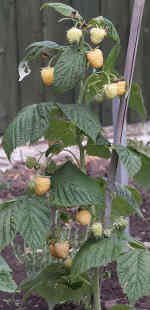 Autumn Raspberries:
Autumn Raspberries:
Autumn raspberries are a wonderful end to the gardening season. I'm growing the variety All Gold from Suttons Seeds - in U.K. - which has attractive gold coloured fruits.
These attractive autumn fruiting varieties produce fruit in the first year. At this time of year I can't expect loads but, they are a welcome addition to my breakfast cereal. But the season has lasted from 25 August pictured right to the 8 November (left) and still going.
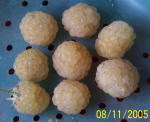 On picking raspberries:
On picking raspberries:
Most gardeners advise that the whole fruit be gently lifted off the central cone or hull when it's ready. But you may notice that the remaining cone shaped receptacle tissue stays fleshy and damp. Soon it begins to go brown. It seems like an open invitation to fungal infection. So after picking the fruit I cut these off with scissors. May be it's unnecessary. May be I'm too fussy. But fruit left too long on the cane or after picking can go creamy pale, soft and squashy. I haven't yet seen significant amounts of botrytis spores.


